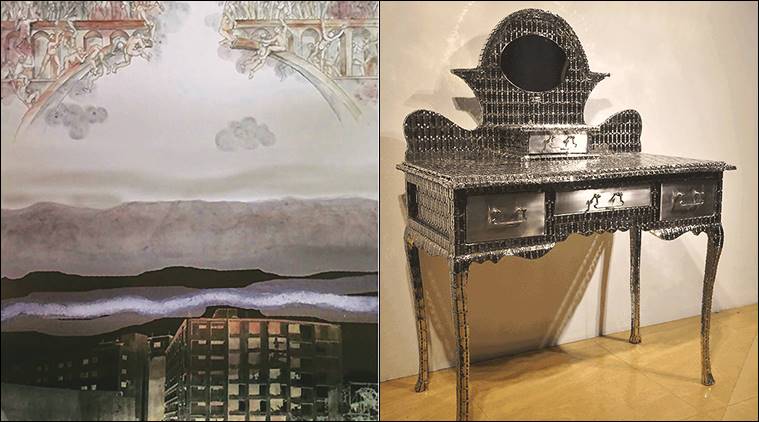The Melting Pot
An exhibition of South Asian artists presents contemporary issues inherent in the region

Works by Sri Lankan artist Anoli Perera (left); Bangladesh’s Tayeba Begum Lipi.
A dressing table clad with thousands of razors resting at the gallery in Bikaner House, designed by one of Bangladesh’s leading artist Tayeba Begum Lipi, appears glittery and attractive from a distance but reveals a rather bitingly painful truth. The object that has chronicled the faces of countless women since time immemorial, in Begum’s installation titled Once Upon a Time, serves as a reminder of how women are suppressed and subjugated.
Art historian and curator of the show Yashodhara Dalmia says, “Women not just in Bangladesh but all over the world have such dismally secluded and violated lives. Tayeba is talking about this violation and her right to exist as an individual through her works.” The installation is part of the exhibition “The Edge” that brings together 17 artists to render a South Asian narrative that reflects the turmoil and issues characteristic of their region in contemporary times.
Dalmia says, “What we had noticed was contemporary artists were reflecting upon the tumultuous and the turbulent history in their works. It was just not India, but the whole subcontinent — Sri Lanka, Bangladesh, Nepal and Pakistan. They also have a way of overturning this turmoil, showing how we can transcend it and the optimism to be followed. That’s why the title ‘The Edge’ is appropriate, showing how borders within the subcontinent are in a sizzling, steamy kind of a situation. Within the country itself, there are so many divisions. There is polarisation, divisions at the borders, and then there are the lower castes, the marginalised and women being further marginalised.”
Clouds of migrants struggling to fit in to the grids of buildings of a city is Sri Lankan artist Anoli Perera’s way of making the viewer face the uncomfortable realities of today’s world through her canvas Masked V. Pointing to how her work renders a bigger idea of the city, she says, “Many people are thrown out of cities and countries. We see human exodus all the time, like in the case of the Rohingyas or the Syrian refugees. We watch it from a long distance thinking it won’t happen to us. People in urban cities are also marginalised, where they live as migrants.”
Delhi-based artist Sumedh Rajendran sculpts men walking through a steel fence as he weaves the concept of insider-outsider. He says, “It is visible in our own social structure and sometimes it transforms into the concept of the ‘other’. It is about the ‘others’, be it in Palestine or Syria or anywhere at the borders. These separations are not visible and the work talks about their invisibility.”
Nepali artist Karan Shrestha’s untitled ink on cotton rag paper work from his series Moreover, in black-and-white, speaks of the upheavals in his country. An armed woman soldier looks at a group of people exiting a landscape, as a tiger awaits on the other side, stationed right beside a helicopter. The artist, who keeps travelling between Kathmandu and Mumbai, says, “In the past two decades, Nepal has been through a lot — the civil war, the fall and collapse of monarchy, the constitution that was waiting to be formed, the earthquake, the trade blockade and social and economic upheavals. There have been so many ruptures. When I had done the series last year, we had nine prime ministers in 10 years. The work talks about all of this.”
The exhibition is at Bikaner House, Delhi, till September 22






















No hay comentarios:
Publicar un comentario